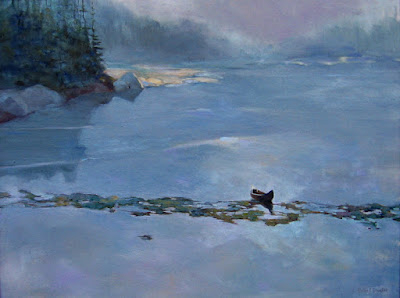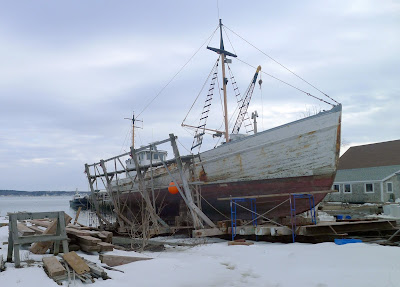The locals were eager to share their million-dollar views and, by the way, did we need a washroom?
 |
| Ed and I did multiple value studies trying to sort out our painting sites for today. |
The Canadian Maritimes shipbuilding industry dates to 1606, when two small boats were built at Port Royal. The availability of timber and proximity to the sea meant that by the nineteenth century, Nova Scotia’s shipyards were recognized worldwide.
There’s no sign of this boatbuilding industry left today, but
Parrsboro built 10 barks, 2 barkentines, 11 brigs, 187 schooners, 1 full-rigged ship, and 41 brigantines. How do I know? At four in the afternoon, while I was sorting photos on my computer,
Ed Buonvecchio was reading Parrsboro history.
Meanwhile,
Poppy Balser was sitting on a stoop Instagramming and
Mary Sheehan Winn was drafting a lobster boat. We were scattered along the harbor but linked by our cell phones.
Ed and I spent the morning doing value studies of possible locations. Because we’re in one car, we needed to agree on our final locations, without a lot of last-minute discussion. We listed the possibilities and then each listed them in order of priority. Our lists ended up being very nearly identical. In the end only one question remained: should we choose the Two Island overlook with the blue roof or the red roof?
Nova Scotians are very friendly. Several stopped to chat as we worked. Inevitably, they suggested that they, in fact, had a better view from their back deck. And, by the way, did we need a washroom?
At one point, I tossed my keys to Ed and took off with a stranger in his Ford F-150, which is the official truck of Canada. I wasn’t overly worried. He’d mentioned that he’d met his hero, George Herbert Walker Bush, several times. A man with such taste had to be trustworthy. He turned out to be charming and witty, and I returned to his property several times, to show it to Poppy and Ed in succession.
Thanks to Mary and her local connections, I’ve learned a lot about Parrsboro in two short days. In addition to her living relatives, she’s related to someone in every cemetery in town. “Aw, hello, Uncle Remus!” she would exclaim as we passed an old burying ground. “Hello, Cousin Louise!” At one point, she jumped from the car and tore crosslots looking for a grave. She caught up with me at the bottom of the hill, breathless. “That was easier than I expected,” she puffed.
That insider information made me smug. “Poppy,” I said when she arrived, “I know absolutely everything.”
“Do you know where the weir is?” she challenged.
Fishing weirs are an ancient technology for catching tidal fish, dating back to prehistory. They’re dying out now, but Poppy
is a master at painting them. And Parrsboro has one, just across the water from Parrsboro’s hypermodern
tidal turbine, which unfortunately failed under the enormous hydraulic pressures of the Bay of Fundy and is being rebuilt this spring.
After we visited the weir, we took off at breakneck speed. I had less than three hours to show her all the sights before we were expected for the opening festivities. We were so short of time that I changed my shirt in the parking lot of the
Cape D’or Lighthouse. It was so desolate that I could have had a sponge bath with nobody noticing.
We arrived back in Parrsboro with enough time to wash our faces and hands and scurry in to our appointment. By the time you read this, we’ll be out in
Port Greville painting. Can you tell I’m excited?
























